engine MERCEDES-BENZ SPRINTER 2019 MY19 with no MMS Operator’s Manual
[x] Cancel search | Manufacturer: MERCEDES-BENZ, Model Year: 2019, Model line: SPRINTER, Model: MERCEDES-BENZ SPRINTER 2019Pages: 322, PDF Size: 5.91 MB
Page 68 of 322

Doors
Un
locking and opening thed oor from inside #
Tounlo ckand open thef ront door: pull
door handle 2.
Lockin gpin1 pops up when thed oor is
unloc ked. #
Open thed oor. The
0036 symbol indicates that ther ear door is
unloc ked. #
Tounlo ckand open ther ear door: pull
opening le ver1and open ther ear door.
When thed oor unloc ks,latch 2moves
fo rw ard.
The 0036 symbo lisvisible. #
Toclose: pullther ear passenger compart‐
ment door closed bythed oor handle. #
Tolock: slide latch 2down.
The 0037 symbol is visible. Locking
thed oor centrall yfromi nside &
WARNING Risk of accident and injury
du etoc hildren lef tunat tende dint he
ve hicle
If ch ildren ar eleftu nat tende dint hevehicle,
th ey could:
R opendoors,t hereb yendangering other
persons or road users.
R geto utofthev ehicle and be hit by
oncomin gtraffic.
R operat evehicle equipment and become
trapped, fore xamp le.
In addition ,children could also se tthe vehicle
in motion, fore xamp le,by:
R releasing thep arking brake.
R shifting thea utomatic transmission out of
par kposition 005D.
R startin gthe engine #
Neverlea ve children and animals unat‐
te nde dint hevehicle. #
When leaving thev ehicle, alw ayst ake
th eS martK eywit hyou and loc kthe
ve hicle. #
Keep theS martK eyout of ther eac hof
ch ildren. &
WARNING Risk offata linjur ydue to
ex posur etoextreme hea torcoldint he
ve hicle
If people –particular lych ildren –areexposed
to extreme temp eratures overane xtended
perio doft ime,ther eisar isk of serious or
eve nfatal injur y. #
Neverlea ve anyone –p articularly chil‐
dren –unat tende dint hevehicle. #
Neverlea ve animals in thev ehicle unat‐
te nded. Lo
cking and unlocking manually
Yo uc an use thec ent rallockin gbuttons tocen‐
trally loc kand unloc kthe entir evehicle from the
inside.
The central lockin gbuttons ar elocated in the
driver's and co-driver doors. 44
Opening and closing
Page 79 of 322

#
Tointer rupt convenience closing: release
the 0037 button. Re
setting thes ide windo ws The side windo
wsmus tber esetafter am alfunc‐
tion or avoltag esuppl yinter ruption. #
Swit chon thei gnition (/ page103). #
Pushbothw indo wlifte rb uttons and hold for
appr oximately one second af tert he side win‐
do wh as closed. Problems with
thes ide windo ws Problem
Possible causes/consequences and 0050 0050Solutions
As ide windo wcann otbe
closed and thec ause is
no to bvious. #
Chec ktos ee ifther ea reanyo bject sinthe windo wguide.
& WARNING Risk of becoming trapped or fata llyi njured if reve rs‐
ing pr otection is no tactivated
If yo uc lose aside wind owagain immediatel yafter it has been
bloc ked, thes ide windo wwill close wit hincreased or maximum
fo rc e. The reve rsing featur ewillthen no tbea ctive.
Pa rtsoft he body could become trapped in thec losing area in the
process. #
Mak esuret hat no parts of theb ody ar einthe closing area. #
Tostop thec losing process, release theb utton or press the
button again tore-ope nthe side windo w. If
as ide windo wisobstructed during closing, and reopens again slightl y,
yo uc an proceed as follo ws: #
Immedia tely afte rt he windo wisobstructed, pull thec orresponding
button again until thes ide windo whas closed, and hold theb utton
fo rana dditional second.
The side windo wisclosed wit hincrease dforce.
If th es ide windo wisobstructed again and reopens slightl y,yo uc an pro‐
cee dasf ollows: #
Repeat thep reviou sstep.
The side windo wisclosed without thea utomatic reve rsing function.
The side windo wscannot
be opened or closed
using thec onvenience
opening feature. The SmartK
eybatter yisweak or discharged. #
Chec kthe batter ywitht he batter ychec klam pand replace if neces‐
sar y(/pag e42). Anti-thef
tprote ction Fu
nction of thei mmobilizer The immobilize
rpreve nts your vehicle from being
st ar tedw ithout thec orrect key.
The immobilizer is automaticall yactivated when
th ei gnition is switched off, and deactivated when
th ei gnition is switched on. When leaving
thev ehicle, alw ayst aket he key
wit hyou and loc kthe vehicle. If thek eyis left
inside thev ehicle, an yone can star tt he engine.
% In
thee vent thee ngine does no tstart despi te
th ev ehicle's star terb atter yhaving suf ficient
ch arge ,the immobilizer is defective. Contact
aq ualified specialis tworks hop or call
1-800-367-63 72(intheU SA)or
1-800-387-0 100( in Canada). Openin
gand closing 55
Page 89 of 322
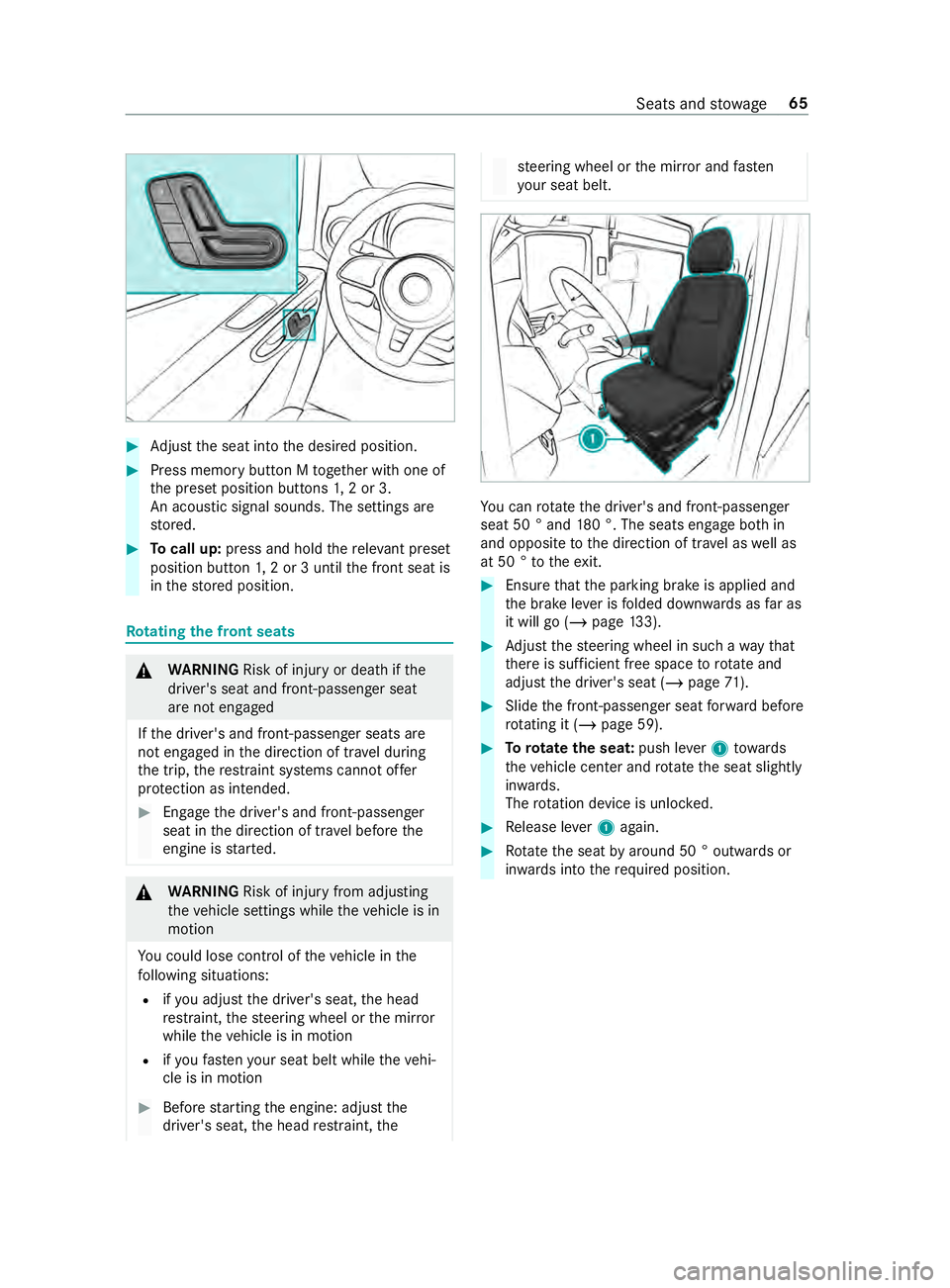
#
Adjus tthe seat int othe desired position. #
Press memor ybutton Mtogether wit hone of
th ep rese tp osition buttons 1,2or3.
An acou stic signal sounds .The settings are
st ored. #
Tocall up: press and hold ther ele vant preset
position button 1,2or3u ntilthef ront seat is
in thes tore dp osition. Ro
tating thef ront seats &
WARNING Risk of inju ryor deat hifthe
driver's seat and front-passenge rseat
ar en otengaged
If th ed rive r's and front-passenger seats are
no te ngaged in thed irection of tr avelduring
th et rip, ther estraint sy stems cann otoffer
pr otection as intended. #
Enga gethed rive r's and front-passenger
seat in thed irection of tr avel befor ethe
engine is star ted. &
WARNING Risk of inju ryfrom adju sting
th ev ehicle settings while thev ehicle is in
motion
Yo uc oul dlose control of thev ehicle in the
fo llowing situations:
R ifyo ua djus tthe driver's seat, theh ead
re stra int ,the steering wheel or them irror
while thev ehicle is in motion
R ifyo uf asteny our seat belt whilet hevehi‐
cle is in motion #
Befor estarti ngthee ngine: adjus tthe
driver's seat, theh ead restra int ,the st
eering wheel or them irro ra nd fast en
yo ur seat belt. Yo
uc an rotate thed rive r's and front-passenger
seat 50 °and 180°.T he seats engag ebothin
and opposit etothe direction of tra velasw ell as
at 50 °totheexit. #
Ensur ethat thep arking brak eisapplied and
th eb rake leve risf olded down wardsasf ar as
it will go (/ page133). #
Adjus tthe steering wheel in suc hawaythat
th er eiss ufficient free space torotate and
adjus tthe driver's seat (/ page71). #
Slide thef ront-passen gers eat forw ardb efore
ro tating it (/ page 59). #
Torotat ethe sea t:push le ver1towa rds
th ev ehicle center and rotat ethe seat slightly
in wa rds.
The rotatio nd eviceisu nlocked. #
Release le ver1again. #
Rotate thes eat byaround 50 °outwa rdsor
in wa rdsi ntot he requ ired position. Seat
sand stow age 65
Page 96 of 322

#
Movethes teering wheel tothed esired posi‐
tion. #
Pull le ver1up as farasitw illg o.
The steering wheel is loc ked. St
ow agea reas Note
sonl oading guidelines &
DANG ER Risk of poisonin gfrome xhau st
ga ses
Combustion engines emit poisonous exhaust
ga ses, suc hascarbon monoxide. Exhaust
ga ses can enter thev ehicle interior if the
re ar-en ddoor is open when thee ngine is run‐
ning ,especially if thev ehicle is in motion. #
Alwayss witc hoffthee ngine before
opening ther ear-end door. #
Neverd rive wit hthe rear-en ddoor
open. &
WARNING Risk of inju ryfrom unsecu red
object sinthevehicle
When objects ar eunsecured or inadequately
secured, they can slip, tip overorbet hrown
about, striking vehicle occupants.
This also appliest o:
R Luggag eorl oads
R Seats whic hhave been remo veda nd are
being transpor tedint hevehicle in an
ex ceptiona lcase
The reisar isk of injur y,particular lyin the
eve nt of braking maneuver sorabrupt
ch anges in direction. #
Alwayss towo bjectsins uchaw aythat
th ey canno tbetossed about. #
Befor etrave ling, secur eobjects, lug‐
ga ge or load topreve ntthem slipping or
tipping over. #
When aseat is remo ved, keep it prefera‐
bly outside thev ehicle. &
WARNING Risk of inju rydue toobjects
being stowedincor rectly
If yo udon otadequatel ystowo bjectsint he
ve hicle interior ,the yc ould sli porbet ossed
around and thereb ystrik evehicle occupants.
In addition, cup holders, open stowage
spaces and mobile phon ebrack etsc annot al
wa ys restra in theo bject stheyc ontai nint he
eve nt of an accident.
The reisar isk of injur y,particular lyin the
eve nt of sudden braking or asudde nchange
in direction. #
Alwayss towo bjectsins uchaw aythat
th ey canno tbetossed about in these or
similar situations. #
Alwaysm akes uret hat objects do not
project from stowages paces, parcel
nets or stowagen ets. #
Close thel oc kable stow ages paces
befor estarti ngajou rney. #
Stow and secur eobject sthat ar eheavy,
hard, poin ted, sharp-edged, fragile or
to ol arge inthec argo compartment. &
WARNING Risk of bu rning from thet ail‐
pipe or tailpipe trim
The tailpipe and tailpipe trim can become
ve ry hot. If youc om eintoc ontact wi th these
car parts, youc oul db urny ourself. #
Alwaysbep articularly careful when in
th ev icinit yoft hetailpipe and tailpipe
trims and supervise children very
closely whe ninthis area. #
Befor eanycon tact, allo wthe car parts
to cool down. If
yo ua reusin gar oofrack ,p lease no tethem axi‐
mum roof load and them aximum load capacity of
th er oof rack.
Yo uw illfind information abou tthe maximum roof
load in the" Tech nical data" chap tera nd informa‐
tion abou troof rack sint he "Car rier sy stems"
section .
Camera-based driving sy stems and thes ensor
functions of thei nside rearvie wmirro rm aybe
impaire difyou ar etranspo rting aload on the
ro of and it pr otru des mor ethan 16in (40 cm)
ove rthe edg eoftheroof. Therefore, mak esure
th at thel oad does no toverhang bymor ethan
16 in (40 cm).
The handlin gcharacteristics of your vehicle are
dependent on thel oad distribution. Therefore,
please obser vethef ollowing no tesw hen loading:
R when transporting aload, ne vere xceed the
permissible gross mass or theg ross axle
we ight rating fort he vehicle (including occu‐ 72
Seats and stowage
Page 108 of 322

When
youa re re placing thel ight bulb, obser ve
th ef ollowing:
R Do no tuse an ybulb that has been dropped or
has scratches on its glass tube .Otherwise,
th eb ulb ma yexplode.
R Theb ulb ma yexplod eifitish otor if you
to uch, drop or sc ratchi t.
R Stains on theg lass tube reduce theb ulb's
service life. Do no ttouc hthe glass tube with
yo ur bar ehands. If necessar y,clea nthe glass
tube wit halcohol or spirits in acolds tate and
wipe it down wit halint-freec loth.
R Protect bulbs from humidity and do no tbring
th em int ocontact wit hliquids.
Alw ayse nsur ethe bulbs ar efirml ysecured.
If yo ur vehicle is equipped wit hLED lamps, you
can checkt his as follo ws :the light cone will mo ve
from toptob ottomand bac kagain when the
engine starts .For this to wo rk,the lo wbeam
needs tohave been switched on befor ethe
engine is star ted.
Bulbs and lights ar eamajor par tofvehicle
saf ety. Therefore, ensur ethat they area lways
wo rking. Ha vetheh eadlam psetting checkedr eg‐
ular ly.
R Befor echanging thel amps, switc hoffthe
ve hicle's lighting sy stem. This will pr event a
sho rtcircuit.
R Use bulbs only in closed lights that ha vebeen
designed fort hem.
R Use onl yspar ebulbs of thes ame type and
wit hthe cor rect voltage.
If th en ew bulb also does no tlight up, consult a
qu alified specialis tworks hop. Re
placing fron tlight bulbs (vehicles with hal‐
ogen headlamps) Overvie
woffront bul btypes
Yo uc an chang ethe following bulbs. Halogen headlamps
1 High beam/daytime running la mps:
H1 555W /15W
2 Lowb eam/perime terl igh t:H7 55 W/W 5W
3 Turn signal: 345 7NAK 28 W
Changing the halogen headla mps
Re quirements:
R Lowb eam: light bulb type H7 55 W
R High beam/daytim erunnin glights: light
bulb type H1 555W/15W
R Perime terl ights: light bulb typ eW5W
R Turn signal indicators: bulb type 3457NAK
28 W 1
Lowb eam/perime terl ights housing co ver
2 High beam/daytim erunnin glights housing
co ver
3 Indicator soc ket #
Switc hoffthel ighting sy stem. 84
Light and vision
Page 124 of 322
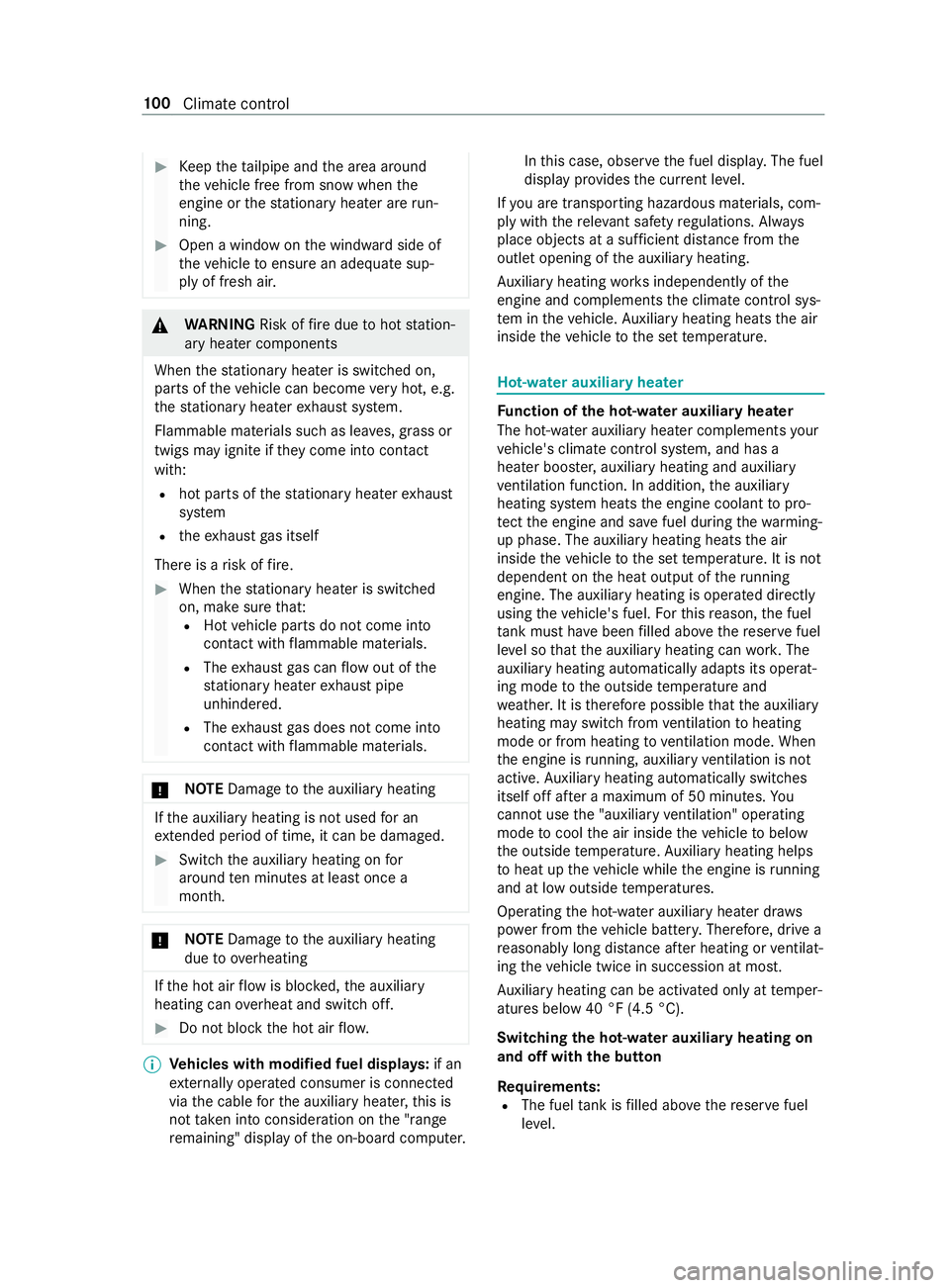
#
Keep thet ailpipe and thea reaa round
th ev ehicle free from sno wwhen the
engine or thes tationar yheater ar erun‐
ning. #
Open awindo wont he windwar dside of
th ev ehicle toensur eana dequat esup‐
ply of fresh air. &
WARNING Risk offire due tohots tation‐
ar yh eater components
When thes tationa ryheater is swit ched on,
parts of thev ehicle can become very hot, e.g.
th es tationa ryheater exhaus tsyst em.
Flammable materials suc hasleaves, grass or
twigs ma yignit eift heyc ome int ocontact
wi th:
R hotp arts of thes tationa ryheater exhaust
sy stem
R thee xhau stgasitself
Ther eisar isk offire. #
When thes tationar yheater is swit ched
on, mak esuret hat:
R Hotvehicle parts do no tcome into
contact wit hflammable materials.
R The exhaus tgas can flow out of the
st ationar yheater exhaus tpipe
unhindered.
R The exhaus tgas doe snotcome into
contact wit hflammable materials. *
NO
TEDama getothea uxiliar yheating If
th ea uxiliar yheating is no tused foran
ex tende dperiod of time ,itcan be damaged. #
Switc hthe auxiliar yheating on for
around tenm inutesatl eastonce a
month. *
NO
TEDama getothea uxiliar yheating
due toove rheating If
th eh otair flow is bloc ked, thea uxiliary
heating can overheat and switc hoff. #
Do no tbloc kthe ho tairflow. %
Ve
hicles with modified fuel displa ys:if an
ex tern all yo perated consume risconnec ted
via thec able fort he auxiliar yheater ,this is
no ttaken in toconside ratio nont he "range
re maining" displa yofthe on-boar dcomputer. In
this case, obser vethef uel displa y.The fuel
displa yprovide sthe cur rent le vel.
If yo ua retranspo rting hazardous materials, com‐
ply wit hthe releva nt sa fety regulations. Alw ays
place objects at asufficient dis tance from the
outle topening of thea uxiliar yheating.
Au xilia ryheating worksi ndependentl yofthe
engine and complements thec limat econt rols ys‐
te mint hevehicle. Auxilia ryheating heats thea ir
inside thev ehicle tothes ettemp erature. Hot-water auxiliar
yheater Fu
nction of theh ot-wat er auxiliar yheater
The hot-water auxiliar yheater complements your
ve hicle's climat econt rols ystem, and has a
heater boos ter,auxiliar yheating and auxiliary
ve ntilation function. In addition, thea uxiliary
heating sy stem heats thee ngine coolant topro‐
te ct thee ngine and sa vefuel during thew arming-
up phase. The auxiliar yheatin gheats thea ir
inside thev ehicle tothes ettemp erature. It is not
dependent on theh eat output of ther unning
engine .The auxilia ryheating is operated directly
using thev ehicle's fuel. Forthis reason ,the fuel
ta nk mus thave been filled abo vether eser vefuel
le ve lsot hatthea uxiliar yheating can work.T he
auxilia ryheating automatically adapts its operat‐
ing mode totheo utside temp eratur eand
we ather .Itist herefor epossible that thea uxiliary
heating ma yswitc hfromv entilation toheating
mode or from heating toventilation mode. When
th ee ngine is running ,auxilia ryventilation is not
acti ve.A uxiliar yheating automatically switches
itself of fafter am aximu mof50m inutes.Yo u
canno tuse the" auxiliar yventilation" operating
mode tocool thea ir inside thev ehicle tobelow
th eo utside temp erature. Auxilia ryheating helps
to heat up thev ehicle while thee ngine is running
and at lo woutsid etemperatures.
Operating theh ot-w ater auxiliar yheater dr aws
po we rfromt hevehicle batter y.Therefore, driv ea
re asonabl ylon gd ista nce af terh eating or ventilat‐
ing thev ehicle twice in succession at most.
Au xilia ryheating can be activated onl yattemper‐
atures belo w40°F(4.5 °C).
Switching theh ot-wat er auxiliar yheatin gon
and of fwitht he button
Re quirements:
R The fuel tank is filled abo vether eser vefuel
le ve l. 100
Climat econtrol
Page 125 of 322
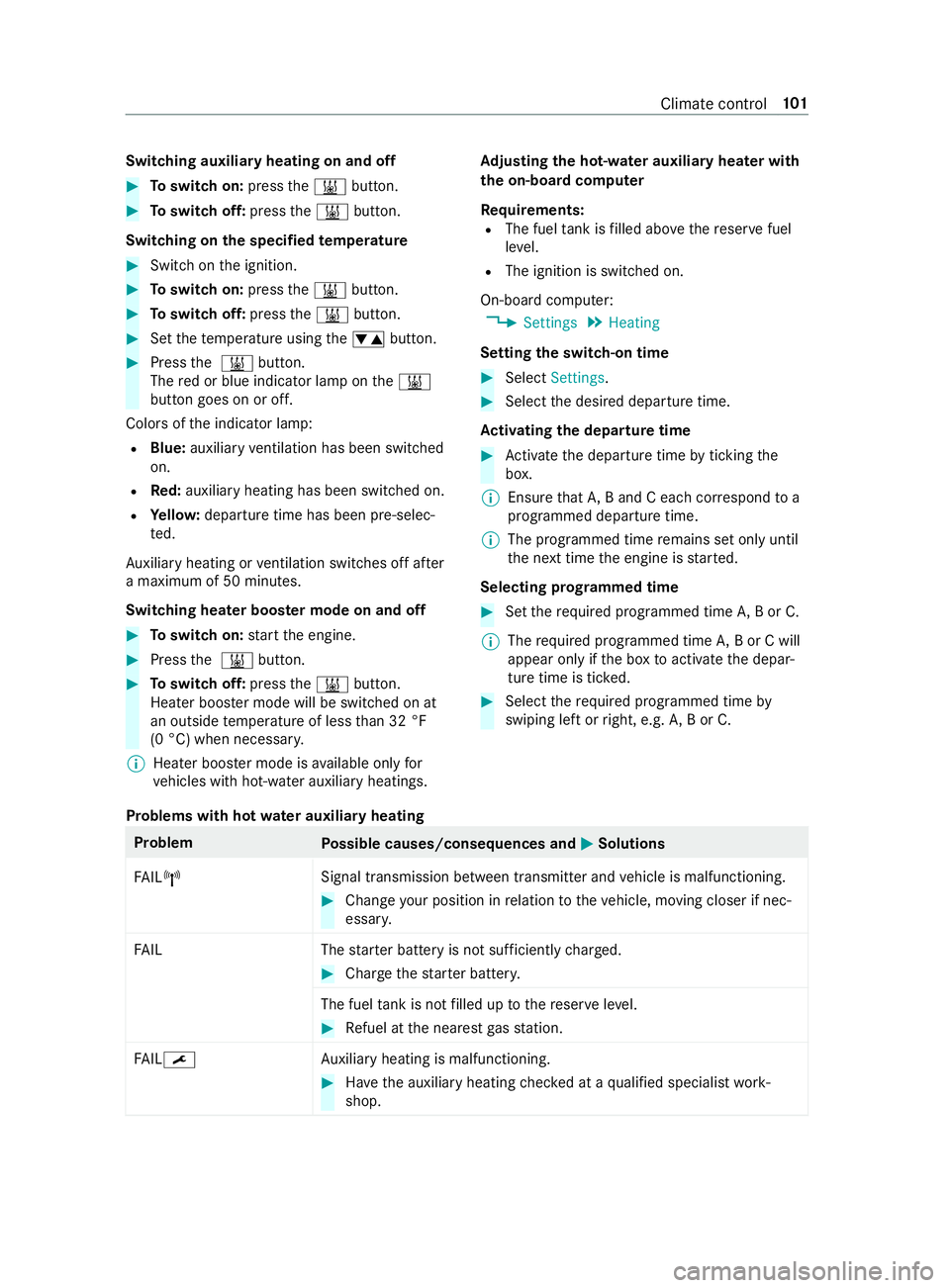
Switching auxiliar
yheating on and off #
Toswitc hon:press the003B button. #
Toswitc hoff:press the003B button.
Switching on thes pecified temperature #
Swit chon thei gnition. #
Toswitc hon:press the003B button. #
Toswitc hoff:press the003B button. #
Setthe temp eratur eusing the0082 button. #
Press the003B button.
The redorb lue indicator lam ponthe003B
button goes on or off.
Color softhe indicator lamp:
R Blue: auxiliar yventilation has been switched
on.
R Red:auxilia ryheating has been switched on.
R Yello w: departur etime has been pre-selec‐
te d.
Au xilia ryheating or ventilation switches of fafter
am aximum of 50 minutes.
Swit ching heater boos term ode on and off #
Toswitc hon:star tt he engine. #
Press the003B button. #
Toswitc hoff:press the003B button.
Heater boos term ode willbes witched on at
an outsid etemperatur eoflessthan 32 °F
(0 °C) when necessar y.
% Heater boo
ster mode is available onl yfor
ve hicles wit hhot-water auxiliary heatings. Ad
justin gthe hot-water auxiliar yheaterw ith
the on-boar dcom puter
Re quirements:
R The fuel tank is filled abo vether eser vefuel
le ve l.
R The ignition is switched on.
On-boar dcomputer:
4 Settings 5
Heating
Setting thes witch-on time #
Select Settings. #
Selec tthe desired departur etime.
Ac tivatin gthe departur etime #
Activat ethe departur etime byticking the
box.
% Ensur
ethat A,Ba ndCe achc orrespond to a
programmed departur etime.
% The programmed time
remains se tonlyu ntil
th en exttime thee ngine is star ted.
Selecting prog rammed time #
Setthe requ ired programmed tim eA,BorC.
% The
requ ired prog rammed time A,BorC will
appea ronly if theb oxtoactivat ethe depar‐
tur etime is tic ked. #
Select ther equired programmed time by
swiping lef torright, e.g. A,BorC.
Problems with ho twater auxiliar yheating Problem
Possible causes/consequences and 0050 0050Solutions
FA IL00A3 Signal transmission between transmitter and
vehicle is malfunctioning. #
Chang eyour position in relation tothev ehicle, moving closer if nec‐
essar y.
FA IL Thestar terb atter yisn otsuf ficiently charge d. #
Charg ethe star terb atter y.
The fuel tank is no tfilled up tother eser veleve l. #
Refuel at then eares tgas station.
FA IL0099 Au
xilia ryheating is malfunctioning. #
Have thea uxiliar yheating checkedataq ualified specialis twork‐
shop. Climat
econtrol 101
Page 127 of 322
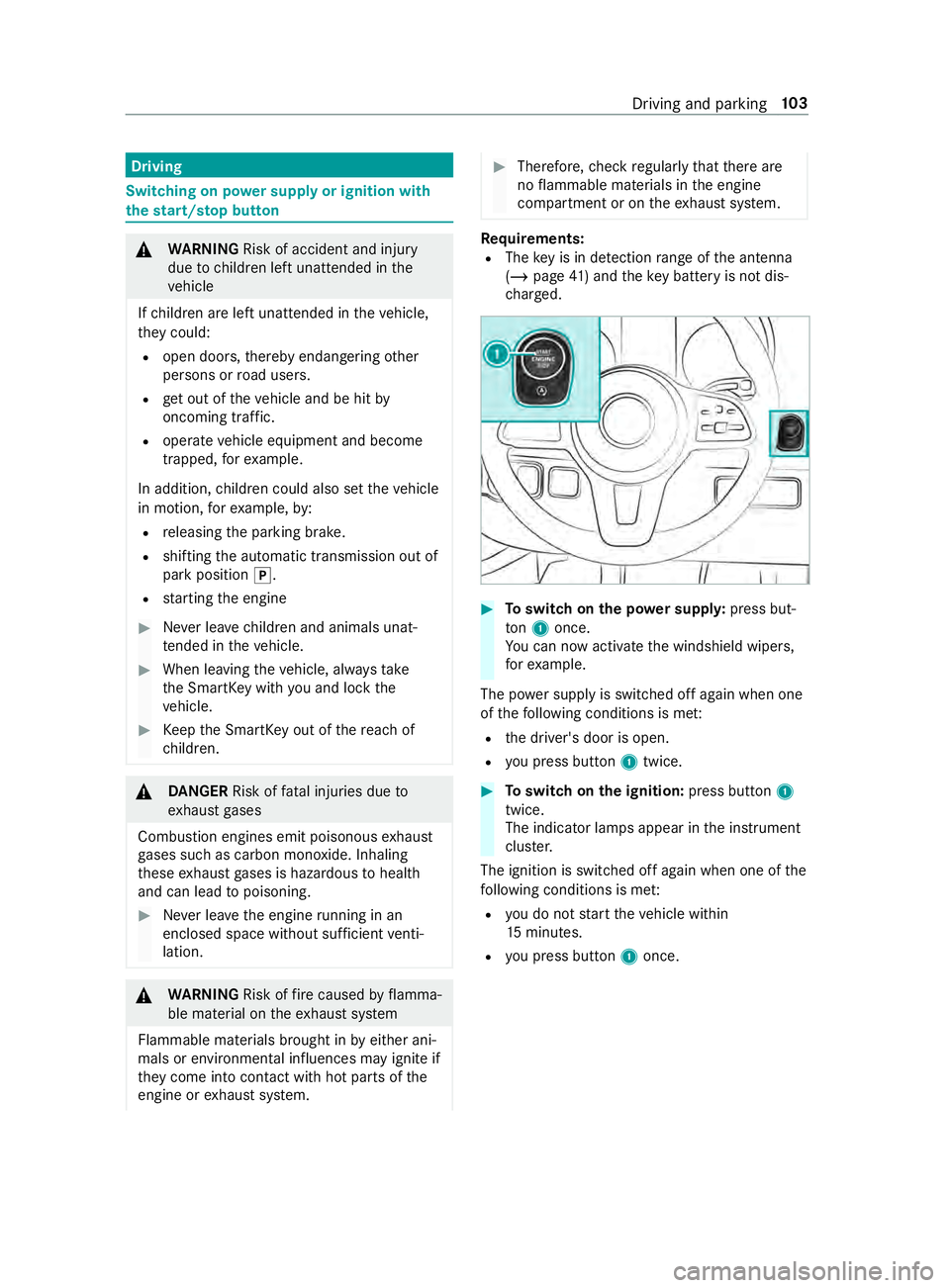
Driving
Swit
ching on po wersuppl yori gnitionw ith
the start/s topb utton &
WARNING Risk of accident and inju ry
due tochildren lef tunat tende dint he
ve hicle
If ch ildren ar eleftu nat tende dint hevehicle,
th ey could:
R opendoors,t hereb yendangering other
persons or road users.
R geto utofthev ehicle and be hit by
oncomin gtraffic.
R operat evehicle equipment and become
trapped, fore xamp le.
In addition ,children could also se tthe vehicle
in motion, fore xamp le,by:
R releasing thep arking brake.
R shifting thea utomatic transmission out of
par kposition 005D.
R startin gthe engine #
Neverlea ve children and animals unat‐
te nde dint hevehicle. #
When leaving thev ehicle, alw ayst ake
th eS martK eywit hyou and loc kthe
ve hicle. #
Keep theS martK eyout of ther eac hof
ch ildren. &
DANG ER Risk of fata linjuries due to
ex haus tgases
Combustio nengines emit poisonous exhaust
ga ses suc hascarbon monoxide. Inhaling
th ese exhaus tgases is hazardou stohealth
and can lead topoisoning. #
Neverlea ve thee ngine running in an
enclose dspace wi thout suf ficient venti‐
lation. &
WARNING Risk offire caused byflamma‐
ble material on thee xhau stsystem
Flammable materials brought in byeither ani‐
mals or environmen talinfluences ma yignit eif
th ey come int ocontact wi thhotp arts of the
engine or exhaus tsystem. #
Therefore, checkr egularly that ther ea re
no flammable materials in thee ngine
compartmen torontheexhaus tsystem. Re
quirements:
R The keyisind etection rang eoft he antenna
(/ page41) and thek eybat tery is no tdis‐
ch arge d. #
Toswitc hont he powersuppl y:press but‐
ton 1once.
Yo uc an no wactivat ethe windshield wipers,
fo re xamp le.
The po wersupp lyis switched of fagain when one
of thef ollowing condition sismet:
R thed rive r's door is open.
R youp ress button 1twice. #
Toswitc hont he ignition: press button1
twice.
The indicator lamps appear in thei nstrument
clus ter.
The ignition is switched of fagain when one of the
fo llowing condition sismet:
R youdon otstar tt he vehicle within
15 minutes.
R youp ress button 1once. Drivin
gand parking 103
Page 128 of 322
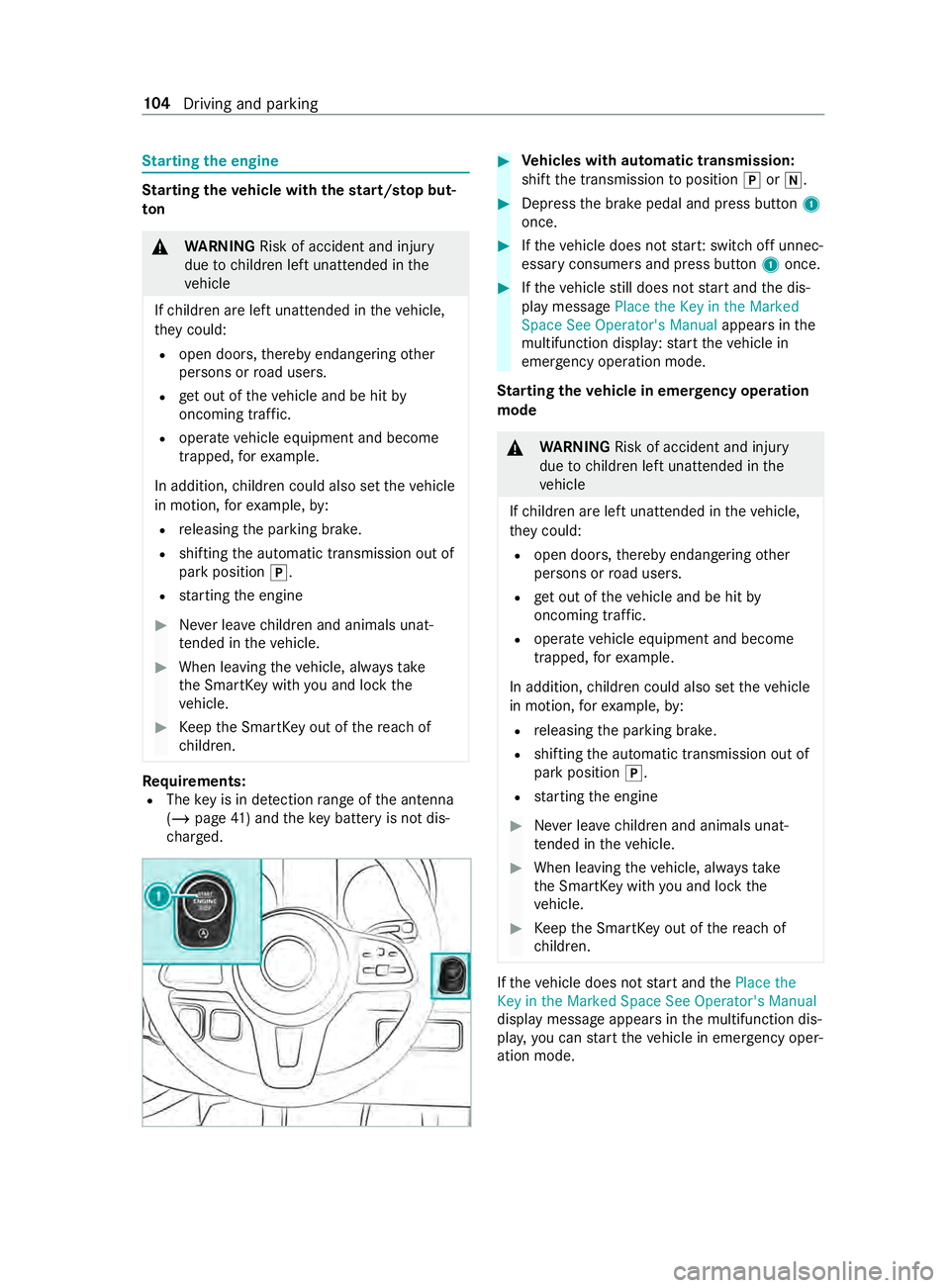
St
arting thee ngine St
arting thev ehicle wit hthe start/s topb ut‐
ton &
WARNING Risk of accident and inju ry
due tochildren lef tunat tende dint he
ve hicle
If ch ildren ar eleftu nat tende dint hevehicle,
th ey could:
R opendoors,t hereb yendangering other
persons or road users.
R geto utofthev ehicle and be hit by
oncomin gtraffic.
R operat evehicle equipment and become
trapped, fore xamp le.
In addition ,children could also se tthe vehicle
in motion, fore xamp le,by:
R releasing thep arking brake.
R shifting thea utomatic transmission out of
par kposition 005D.
R startin gthe engine #
Neverlea ve children and animals unat‐
te nde dint hevehicle. #
When leaving thev ehicle, alw ayst ake
th eS martK eywit hyou and loc kthe
ve hicle. #
Keep theS martK eyout of ther eac hof
ch ildren. Re
quirements:
R The keyisind etection rang eoft he antenna
(/ page41) and thek eybat tery is no tdis‐
ch arge d. #
Vehicles with automatic transmission:
shif tthe transmission toposition 005Dor005C. #
Depress theb rake pedal and press button 1
once. #
Ifth ev ehicle does no tstart:s witc hoffunnec‐
essar yconsumer sand press button 1once. #
Ifth ev ehicle still does no tstart and thed is‐
pla ym essage Place the Key in the Marked
Space See Operator's Manual appearsinthe
multifunction display: star tt he vehicle in
emergency operation mode.
St arting thev ehicle in eme rgency operation
mode &
WARNING Risk of accident and injury
du etoc hildren lef tunat tende dint he
ve hicle
If ch ildren ar eleftu nat tende dint hevehicle,
th ey could:
R opendoors,t hereb yendangering other
persons or road users.
R geto utofthev ehicle and be hit by
oncomin gtraffic.
R operat evehicle equipment and become
trapped, fore xamp le.
In addition ,children could also se tthe vehicle
in motion, fore xamp le,by:
R releasing thep arking brake.
R shifting thea utomatic transmission out of
par kposition 005D.
R startin gthe engine #
Neverlea ve children and animals unat‐
te nde dint hevehicle. #
When leaving thev ehicle, alw ayst ake
th eS martK eywit hyou and loc kthe
ve hicle. #
Keep theS martK eyout of ther eac hof
ch ildren. If
th ev ehicle does no tstart and thePlace the
Key in the Marked Space See Operator's Manual
displa ymessag eappear sinthe multifunction dis‐
pla y,yo uc an star tt he vehicle in emer gency oper‐
ation mode. 104
Driving and pa rking
Page 129 of 322
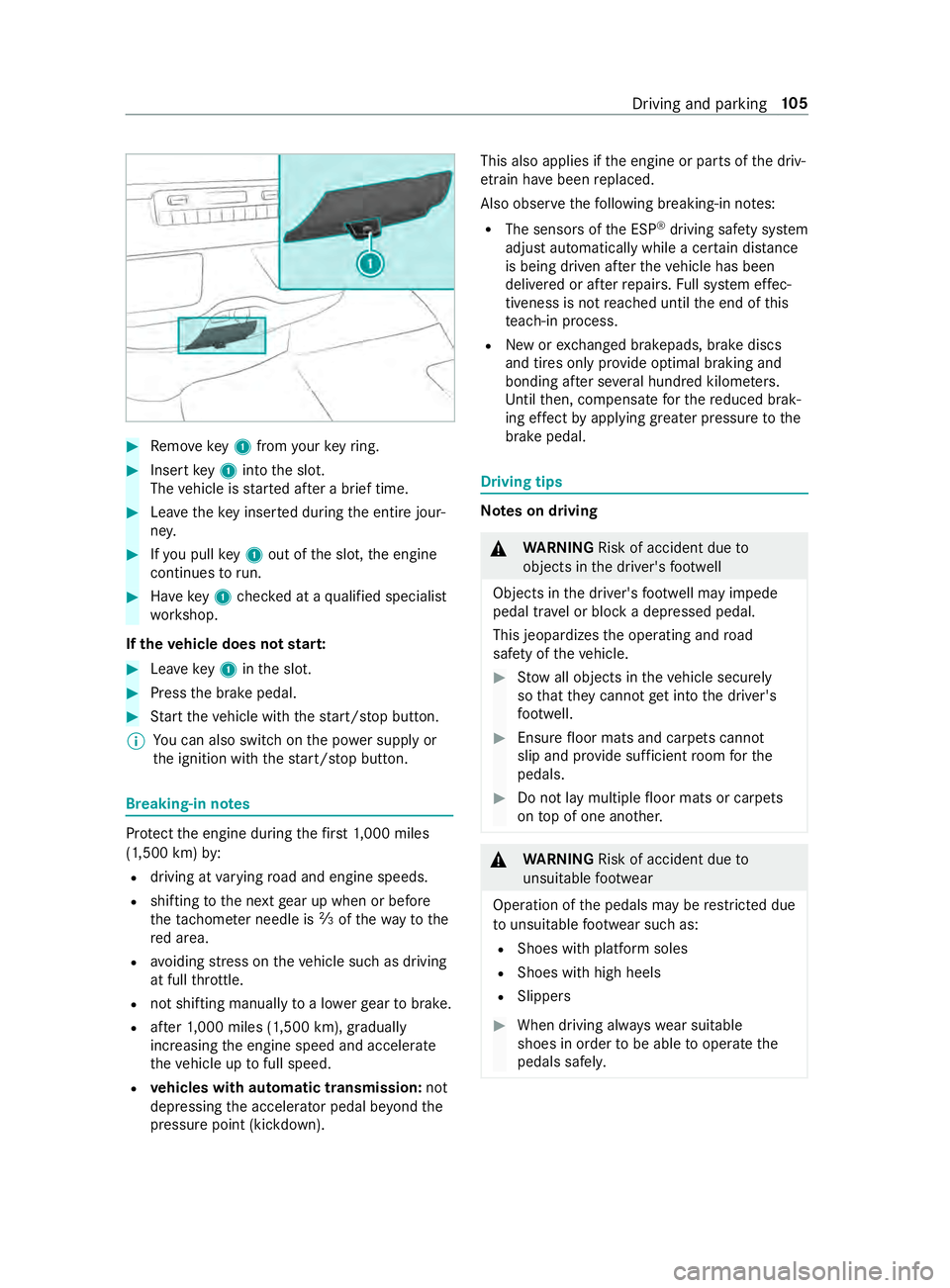
#
Remo vekey 1from your keyr ing. #
Inser tkey 1 intot he slot.
The vehicle is star teda fter ab rief time. #
Leavethek eyinser tedd uring thee ntir ejour‐
ne y. #
Ifyo up ullkey 1out of thes lot, thee ngine
continues torun. #
Have key 1checkedataq ualified specialist
wo rkshop.
If th ev ehicle doe snotstar t: #
Leavekey 1inthes lot. #
Press theb rake pedal. #
Startt he vehicle wit hthe start/ stop button.
% Yo
uc an also swit chon thep ower suppl yor
th ei gnition wit hthe start/ stop button. Breaking-in no
tes Pr
otect thee ngine during thef irst 1,000 miles
(1,500 km) by:
R driving at varying road and engine speeds.
R shiftin gtothe next gear up when or before
th et achome tern eedle is 00C3ofthew ay to the
re da rea.
R avoiding stre ss on thev ehicle suc hasdriving
at full thro ttle.
R nots hifting manuall ytoalowergear tobrake.
R afte r1 ,000 miles (1,50 0km),gradually
increasing thee ngine speed and accelerate
th ev ehicle up tofull speed.
R vehicles with automatic transmission: not
depressing thea ccelera torp eda lbeyo ndthe
pressur epoint (kickdown). This also applies if
thee ngine or parts of thed riv‐
et ra in ha vebeen replaced.
Also obser vethef ollowing breaking-in no tes:
R The sensor softhe ESP ®
driving saf etys ystem
adjus tautomaticall ywhile acertai nd ista nce
is bein gdrive na fter thev ehicle has been
delivered or af terr epairs. Full sy stem ef fec‐
tivenes sisnotreached until thee nd of this
te ach-in process.
R Newore xchanged brakepads, brak ediscs
and tires onl yprovide optimal braking and
bonding af ters everal hundred kilome ters.
Un tilthen, compensat efor ther educed brak‐
ing ef fect by applying greater pressur etothe
brak epedal. Driving tips
Note
sond riving &
WARNING Risk of accident du eto
object sinthe driver's foot we ll
Object sinthe driver's foot we ll ma yimp ede
pedal tr avel or bloc kadepressed pedal.
This jeopardizes theo perating and road
saf etyoft hevehicle. #
Stow all object sinthevehicle securely
so that they canno tget intot he driver's
fo ot we ll. #
Ensur efloor mats and carpets cannot
slip and pr ovide suf ficient room fort he
pedals. #
Do no tlay multiple floor mats or carpets
on topofo ne ano ther. &
WARNING Risk of accident du eto
unsuitable foot we ar
Operatio nofthe pedals ma yberestricted due
to unsuitable foot we ar suc has:
R Shoes wit hplatform soles
R Shoes wit hhigh heels
R Slippers #
When driving alw aysw ear suitable
shoes in order tobe able tooperat ethe
pedals safel y. Driving and pa
rking 105